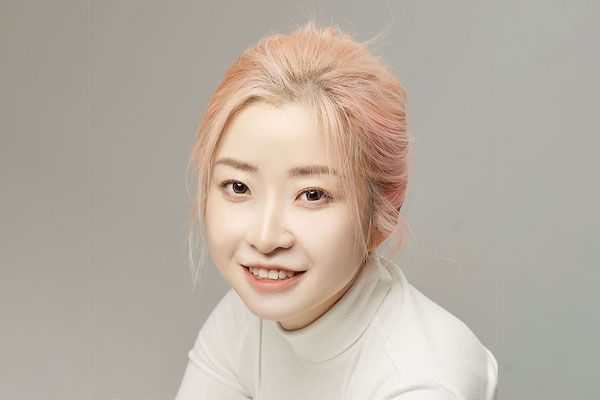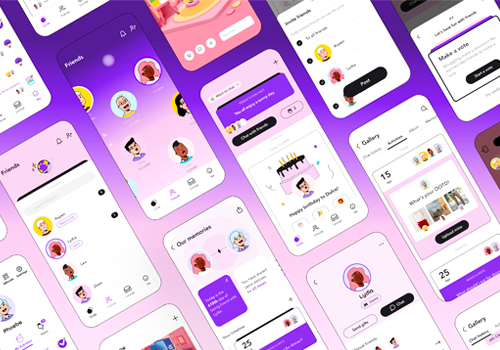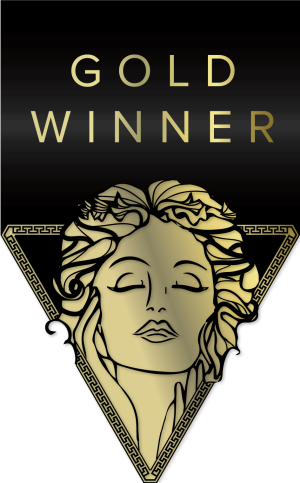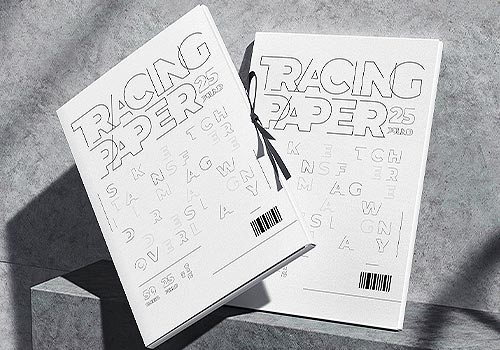
Interview
Yichen Wang
China
Yichen Wang, a designer with an MFA in Communications Design from Pratt Institute, blends academic research with empathetic design principles, focusing on human connections in the digital age. Wang prioritizes users' emotional and social needs in their design approach.
1 Please give us a brief bio of yourself and your creative background.
I am Yichen Wang, a designer whose academic research in the design field intersects with my commitment to empathetic design principles, focusing on the exploration of human connections in our fast-paced, digitally-driven world. My MFA in Communications Design from Pratt Institute has been instrumental in shaping my design approach, where I prioritize the emotional and social needs of users. My philosophy is at the core of 'O'friends,' a mobile application developed to assist young adults in maintaining lasting friendships despite distance and changing life circumstances. 'O'friends' reflects my belief in design's power to appeal aesthetically and address complex emotional aspects of human relationships. The genesis of 'O'friends' stems from observing how technology, while connecting us in many ways, can also enhance feelings of isolation. The app is my response to this modern dilemma, providing a platform for young adults to nurture their friendships, encouraging emotional connections through an intuitive and thoughtful design. My journey as a designer revolves around creating meaningful digital experiences that transcend the boundaries of the screen, touching lives and fostering authentic human connections. Whether through academic research or projects like 'O'friends,' my goal is to enhance the human experience in the digital age by crafting designs that understand and value the intricacies of human emotions and connections.
2 What made you become/why did you choose to become a creative?
I believe that creativity chose me rather than the other way around. From a young age, I have been endowed with a rich imagination and keen insight. This natural disposition has always drawn me towards creation and discovery. The joy I find in the act of creating is immense, and it seemed only natural to pursue a path where I could spend my life doing what brings me happiness. For me, being creative is not just a job; it's a way of contributing to a field that has the power to enrich lives and offer new perspectives. My aim has always been to delve deeper into this realm, to understand it better, and to make meaningful contributions that others can benefit from. I want to inspire and be inspired, believing that creativity is not just an individual pursuit but a collective journey where everyone can benefit from the beauty and innovation it brings to our world.
3 Tell us more about your business/company, job profile, and what you do.
I consider myself a multidisciplinary designer, constantly striving to view and approach design from various angles. This pursuit stems from my intrinsic nature as a person rich in imagination and insight. My educational background, which combined a sensitive approach with logical thinking, laid the foundation for my design philosophy. The book 'Design for the Real World' by Victor Papanek, which I encountered at IDEO, opened my eyes to the immense impact of applying different thought processes to the same problem. In my career, I've been guided by the universal design principle of making the world a better place through our work. Starting as an industrial designer, I explored the relationship between people and objects, at a time when the concept of digital user experience was still nascent. My fascination with human interaction with various mediums led me to delve deeper into this field. Influenced by Japanese design philosophies like 'less is more' and 'unobtrusive design,' which aim to create inclusive designs catering to a broader range of users, I developed a keen interest in identifying and addressing the needs of the often overlooked 20%. Solving these design challenges, akin to solving complex mathematical problems, brought me immense satisfaction. With the proliferation of smartphones, the focus of human-machine interaction shifted predominantly to digital interfaces, and I pivoted towards UX design. Pursuing interdisciplinary collaboration, I was thrilled by the diversity of perspectives from people of different backgrounds working on common problems. However, my in-depth study of the relationship between technology and people also revealed its exploitative potential, as seen in the dystopian visions of cyberpunk culture. Despite my pessimistic view that the widespread use of technology and its associated unhappiness is irreversible, I am determined to find ways through design where people can still find happiness with technology. This led to the creation of 'O'friends' during the pandemic, an app designed to combat loneliness and isolation. This year, witnessing the disruptive growth of AI has been a remarkable experience. As a creator, I'm excited about the powerful new tools at my disposal, which have significantly enhanced my capabilities. In my current role, which involves AI, I remain committed to approaching my work from a human-centric perspective, focusing on users and the human element in technology.
4 What does “creativity” mean to you?
Creativity to me means making things not boring.
5 To you, what makes a “creative” idea and/or design?
For me, a 'creative' idea or design emanates from the ability to redefine and deconstruct a problem before reconstructing it with a fresh perspective. The essence of creativity lies in approaching the same problem through different lenses. As an industrial designer, my analytical approach, aspects of the problem I focus on, and pathways to solutions differ significantly from when I approach it as an interaction designer. Moreover, I pay close attention to how professionals in other creative fields define and understand the same problem. What are their focal points? How do they initiate their process, what actions do they take, and what results do they achieve? Observing these varied approaches and outcomes is incredibly fascinating and enlightening for me.
6 Tell us about your creative and/or design process.
At the heart of my design process is empathy. This means immersing myself in the user's world, understanding their experiences, challenges, and needs from a deeply personal perspective. Empathy guides my every decision, ensuring that my designs are not just visually appealing but also genuinely address the users' problems and enhance their experiences. Alongside empathy, I place a strong emphasis on research. It's crucial for me to identify gaps in my understanding and uncover facts that may differ from my initial thoughts. This research phase involves delving into user behaviors, market trends, and technological advancements. It's not just about gathering information; it's about challenging my assumptions and widening my perspective. I also value seeking diverse viewpoints, although direct collaboration with professionals from different fields is not always part of my process. Gaining insights from various disciplines helps me approach design problems with a more holistic and informed perspective. This combination of empathy, thorough research, and openness to different viewpoints forms the foundation of my creative and design process, enabling me to create solutions that are both innovative and deeply resonant with users.
7 What's your favorite part of the creative process and why?
My favorite parts of the creative process are the interview phase, prototyping, and organizing file names at the end, each offering unique joys and rewards. During interviews, observing people's reactions and hearing their thoughts is fascinating. It's an opportunity to discover new insights and understand the commonalities and differences in people's thinking. This phase is about connecting with others and uncovering valuable perspectives that might not have been considered before. In the prototyping phase, with the knowledge gathered from research, brainstorming solutions becomes an exhilarating exercise in creativity. When a fantastic idea emerges
8 Describe your creative style and its main characteristics.
My creative style strongly emphasizes storytelling and emotional design. In my work, I aim to craft narratives that engage and connect deeply with the audience. A good storytelling approach helps me convey compelling stories that make complex ideas accessible and relatable. Emotional design is central to my designs. I believe in creating designs that evoke feelings and provoke thought, transcending beyond mere functionality. This focus on emotional design is about more than just aesthetics; it's about creating an experience that moves and inspires people.
9 Do you think your country and its cultural heritage has an impact on your creativity process?
The Chinese philosophical tenet '?????????????' has deeply influenced my approach to design and life. This principle, emphasizing different responsibilities based on one's circumstances, aligns with my belief in using design to benefit society whenever possible. It articulates that when one is in a position to effect broader societal change, one should endeavor to do so. Conversely, in situations where the scope of influence is limited, the focus shifts to improving oneself and positively impacting those immediately around us, be it friends, neighbors, or acquaintances. This philosophy guides me in choosing and executing my design projects. When opportunities arise to contribute to larger social causes, I engage wholeheartedly, aiming to create work that benefits the wider community. In projects where the scope is more personal or localized, my focus turns inward, ensuring that even on a smaller scale, my work positively influences those it reaches. My overall practice as a designer is attuned to where and how I can make the most meaningful impact, whether on an individual or societal level, which is always with the intention to bring about positive change through my design work.
10 Congratulations! As the winner of the 2023 MUSE Creative Awards, what does it mean to you and your company and team to receive this award distinction?
Winning the 2023 MUSE Creative Awards is an extraordinary honor and a significant milestone in my career. This prestigious recognition validates my journey in the creative field, affirming that my unique approach to storytelling, emotional design, and commitment to empathetic user experiences are making a discernible impact. This accolade is particularly meaningful as it represents the culmination of my individual efforts, creativity, and perseverance. It is a testament to the countless hours of dedicated work and the passion that drives my projects. Receiving this award not only enhances my credibility and visibility within the creative community but also serves as a powerful motivator. It encourages me to continue pushing the boundaries of creativity, to innovate, and to produce work that resonates on both an aesthetic and emotional level. In essence, the MUSE Creative Awards distinction is a source of immense pride and joy. It stands as a reminder of what can be achieved through creativity and passion, inspiring me to maintain a high standard of excellence in all my future endeavors.
11 Can you explain a bit about the winning work you entered into the 2023 MUSE Creative Awards, and why you chose to enter this project?
For the 2023 MUSE Creative Awards, I entered two projects that are very close to my heart: 'O'friends' in the App - Social Networking category and 'Tracing' in the Typography - Packaging/Product category. Both projects showcase my commitment to storytelling, emotional design, and creating impactful user experiences. 'O'friends' is a mobile application designed to help young adults maintain long-lasting friendships. In today's fast-paced world, where physical distances and life changes often strain friendships, 'O'friends' offers an innovative solution. The app facilitates keeping in touch and sharing experiences, aiming to bridge the gap caused by distance and busy schedules. It's a platform that encourages users to connect meaningfully, emphasizing emotional resonance in digital communication. 'Tracing,' on the other hand, is a project that combines typography and packaging design. It reflects my interest in how visual design and text can work together to create a powerful product experience. This project is an exploration of how typography can be both functional and emotionally evocative, enhancing the user's interaction with the product. I chose to enter these projects into the MUSE Creative Awards because they embody my design philosophy and represent significant achievements in my journey as a designer. 'O'friends' and 'Tracing' are not just designs; they are narratives that speak to the user, stories that engage and inspire. Winning these awards has been an affirmation of my approach to design
12 What was the biggest challenge with this project?
The greatest challenge in creating 'O'friends' was developing a solution to alter the state of isolation or solitude that people often find themselves in, especially during times like the pandemic. Prior to 'O'friends,' I had experimented with various approaches, but the most difficult part was always encouraging users to take that first step to reach out to others or engage with the world around them. To address this, I focused on designing an extremely smooth and attractive landing experience, coupled with thoughtful planning of users' social sharing boundaries. It was crucial to create a sense of belonging and connection within groups, making users feel like they are part of a community. This involved not just aesthetic design choices but also deep consideration of user psychology and social dynamics. The challenge was to balance functionality with emotional appeal, ensuring that users felt comfortable and motivated to initiate and maintain connections through the app.
13 How has winning an Award developed your practice/career?
Winning the MUSE Creative Awards has profoundly influenced my practice and career. The award has significantly enhanced my visibility within the design industry, exposing my work to a broader audience. This includes potential clients and collaborators who appreciate innovative, high-quality design. Such recognition has not only expanded my reach but also enriched the diversity of people I engage with in my professional journey. The accolade has also reinforced my credibility as a designer. It acts as a validation of my skills and creative approach, strengthening my confidence when embarking on new projects or presenting ideas to clients. This recognition has paved the way for more varied and challenging opportunities, allowing me to grow and evolve in my field. Being a recipient of this prestigious award has been a major source of motivation. It has invigorated my passion for design and spurred me to explore beyond my existing creative boundaries. Knowing that my work has stood out in a competitive landscape encourages me to continuously seek new ideas and innovate. Additionally, this achievement has given me a platform to share my insights and experiences with the broader design community. It's an opportunity to inspire and influence fellow designers and contribute to the collective growth and evolution of our industry. Engaging with peers and mentoring the next generation of designers have become integral parts of my professional life, further enriching my experience in the design world.
14 What are your top three (3) favorite things about our industry?
My top three favorite aspects of the creative industry are its continual innovation, the aesthetic experiences it offers, and the unique blend of idealism and pragmatism among its professionals. The creative industry thrives on constant innovation, integrating new ideas with the latest technology. This dynamism keeps the field exciting and inspiring, continually challenging me to expand my creative horizons. The aesthetic beauty that emerges from creative ideas is another aspect I deeply cherish. It
15 What makes your country specifically, unique in the creative industry?
The creative industry in my country is distinctively characterized by its diversity and richness, drawing from a vast cultural and historical tapestry. There has been an abundance of thriving ideas and aesthetic styles, each contributing uniquely to our design heritage. This diversity is evident in everything from philosophical teachings to artistic expressions. The multitude of thoughts that emerged during different historical periods has created a rich reservoir of inspiration for modern designers. For instance, the mesmerizing color schemes and mural-inspired designs from Dunhuang are just a glimpse of the vast artistic wealth our culture offers. Our creative sector benefits immensely from this wealth of cultural diversity. It's not just about revisiting the past; it's about reinterpreting and rediscovering these historical elements in contemporary design. The fusion of traditional aesthetics with modern principles brings a unique flavor to our design work, making it both globally appealing and deeply rooted in cultural authenticity. The plethora of ideas from our history, ranging from ancient philosophies to regional artistic nuances, provides a broad canvas for contemporary creativity. This continual engagement with our rich cultural heritage ensures that the design landscape in my country remains vibrant, innovative, and endlessly fascinating.
16 Where do you see the evolution of creative industry going over the next 5-10 years?
In the next 5-10 years, I foresee the creative industry being significantly reshaped by the advancement of AI. Its revolutionary and disruptive influence will extend across all spheres, profoundly altering our lifestyles. The increasing datafication of our lives will offer more personalized experiences, but it also raises critical questions about the impact on human connections. Will this data-driven personalization bring people closer together and benefit society, or will it deepen misunderstandings and widen gaps between individuals? Predicting these outcomes is challenging. Furthermore, the rise of virtual and augmented reality technologies will likely revolutionize the way we interact with the world around us. These technologies have the potential to create immersive experiences that blend the physical and digital worlds, opening up new avenues for creative expression and user engagement. Sustainability will also become a more pressing concern in the creative industry. As awareness of environmental issues grows, there will be a greater emphasis on sustainable practices, eco-friendly materials, and designs that promote conservation and clean energy usage. This shift towards sustainability will not only be a moral imperative but also a driving force for innovation, pushing creatives to develop solutions that are both environmentally responsible and aesthetically pleasing.
17 If you were a student entering this industry or an aspiring MUSE Creative Awards submitter, what advice would you give them?
For students and aspiring creatives entering the creative industry or considering the MUSE Creative Awards, I'd like to share advice rooted in my own experiences: Embrace a mindset of curiosity and lifelong learning. This industry is constantly evolving, shaped by new technologies and creative trends. My journey has taught me that staying curious and open to continuous learning is crucial. It keeps your skills relevant and fuels your creativity. Don't just follow trends; strive to understand the 'why' behind them. Find and nurture your unique voice. In the diverse world of creative design, what has set me apart is developing a style that reflects my personal experiences and beliefs. Don't be afraid to let your designs tell your story. Authenticity has a powerful resonance in our industry. Build a network, but focus on meaningful connections. Networking has been instrumental in my growth, but it's the deeper, more genuine connections that have truly enriched my career. Seek mentors, engage with peers, and participate in communities, not just for opportunities, but for the rich exchange of ideas and perspectives they offer. Regarding competitions like the MUSE Creative Awards, remember, it's as much about the journey as it is about the accolade. Each submission is a learning experience, a chance to gain feedback, and see where your work stands among peers. My participation has been a journey of growth, self-discovery, and an opportunity to contribute to the vibrant tapestry of our industry.
18 What resources would you recommend to someone who wants to improve their skills in the creative industry?
For anyone looking to enhance their skills in the creative industry, I highly recommend a combination of classic design literature, online learning resources, community engagement, and keeping abreast of industry news. Starting with classic design books is crucial for building a strong theoretical foundation. These texts offer insights into fundamental design principles and the evolution of design thinking. They are essential for understanding the 'why' behind what we do as creatives. Online platforms like Coursera, Udemy, and Skillshare, along with YouTube, are treasure troves for learning almost anything related to design. From mastering software skills to understanding user experience design, these platforms provide access to a wide range of topics taught by industry experts. Networking and community engagement are also vital. Platforms like Behance and Dribbble, as well as local design meetups, offer invaluable opportunities. They are not just for showcasing your work but also for connecting with other creatives, gaining feedback, and staying in tune with current trends and techniques. Lastly, regularly reading industry blogs and magazines is essential to stay updated with the latest trends, tools, and ongoing discussions in the design world. Combining these resources offers a well-rounded approach to skill development in the creative industry. They have been instrumental in my growth and are tools I consistently rely on to refine my craft.
19 Tell us something you have never told anyone else.
One thing I've never shared before is that my grandmother taught me how to whistle when I was just five years old. She thought it was a funny skill to have, and it became a little inside joke between us.
20 Who has inspired you in your life and why?
The person who has profoundly inspired me in my life is my grandmother. Her unwavering belief in me has been my guiding light, especially during challenging times. Whenever I made decisions that might not have been understood by others, she stood by me, offering her support even in areas she might not fully understand herself. Her strength and encouragement have been instrumental in shaping who I am today. My grandmother was a powerful woman with a successful career at a time when women had limited opportunities to work. She navigated numerous challenges and raised her children with resilience and grace. From a young age, she instilled in me the values of kindness and integrity, and she always believed in my potential to carve out a successful career of my own. Her life story and the way she faced societal norms about women's roles have always been a source of motivation for me. In moments when I confronted societal expectations placed on women, I would think of her, drawing strength from her example to remain true to myself. Her confidence in my abilities has been a constant reminder that I can forge my own path and succeed on my own terms.
21 What is your key to success? Any parting words of wisdom?
At the core of my success in the creative industry is my unwavering passion. For me, creation is not just a job; it's a source of joy and fulfillment. I am driven by a desire to craft beautiful things and a deep-seated aspiration to make a positive impact on others through my work. This passion for creation has been my guiding light. It motivates me to continuously hone my skills and expand my abilities. The happiness I derive from creating is what propels me forward, pushing me to explore new ideas, experiment with different techniques, and embrace challenges as opportunities for growth. My advice to others in this field is to find what genuinely excites and fulfills you. Let your passion guide your journey. It


